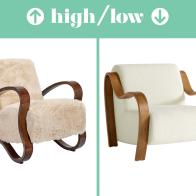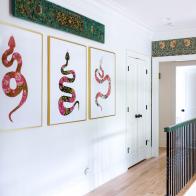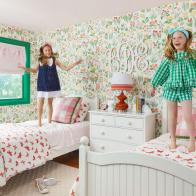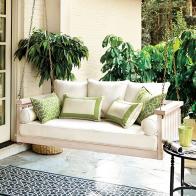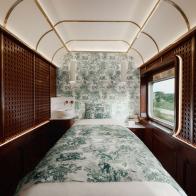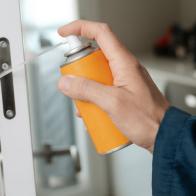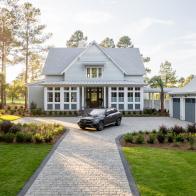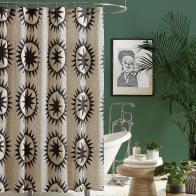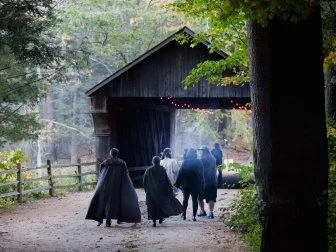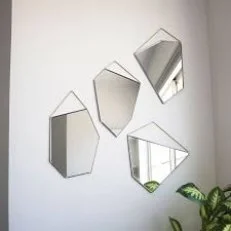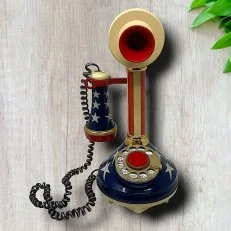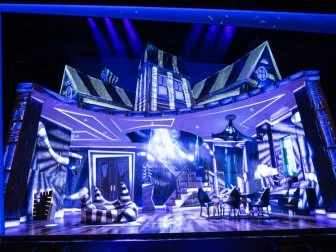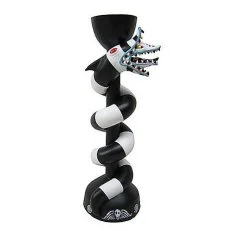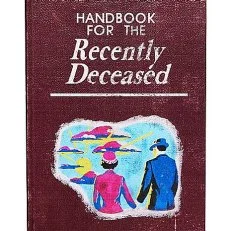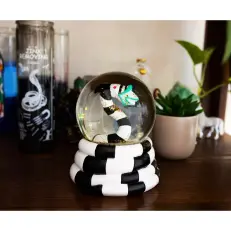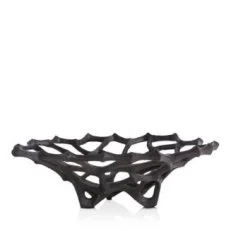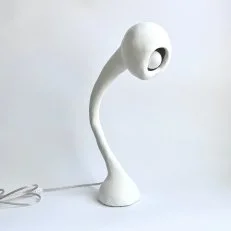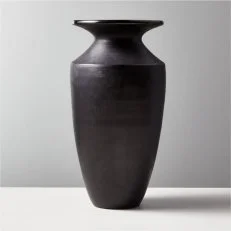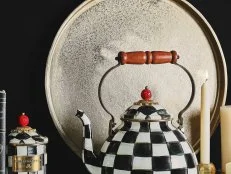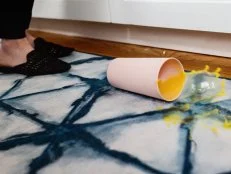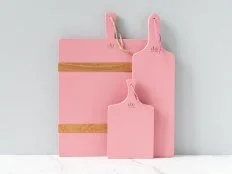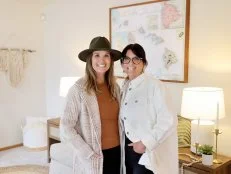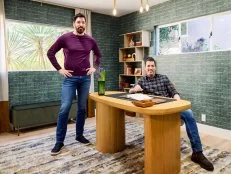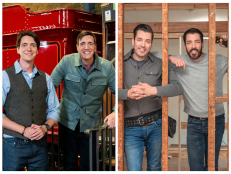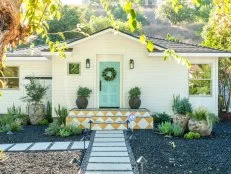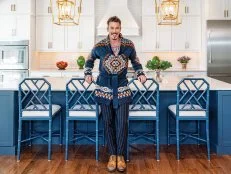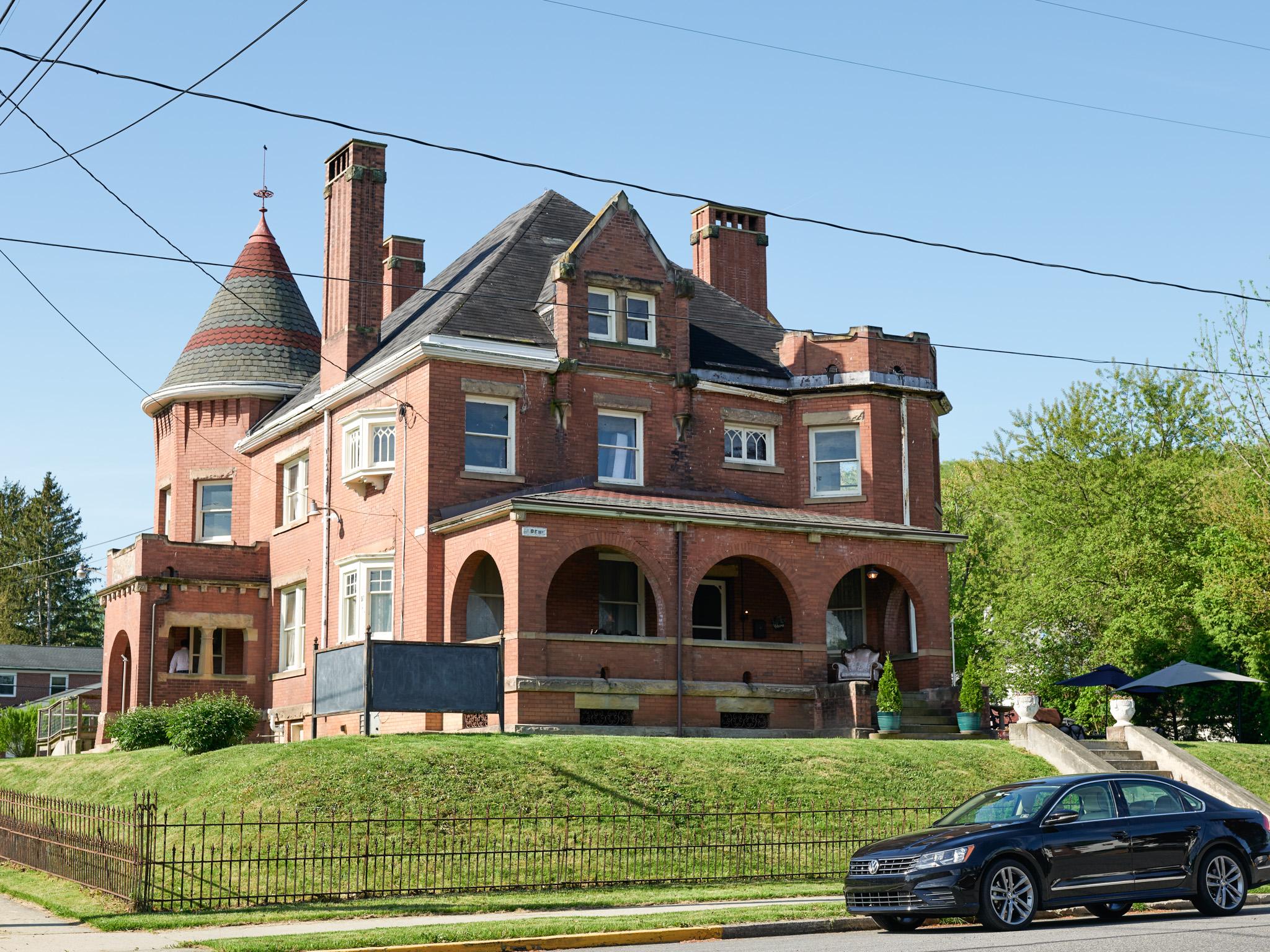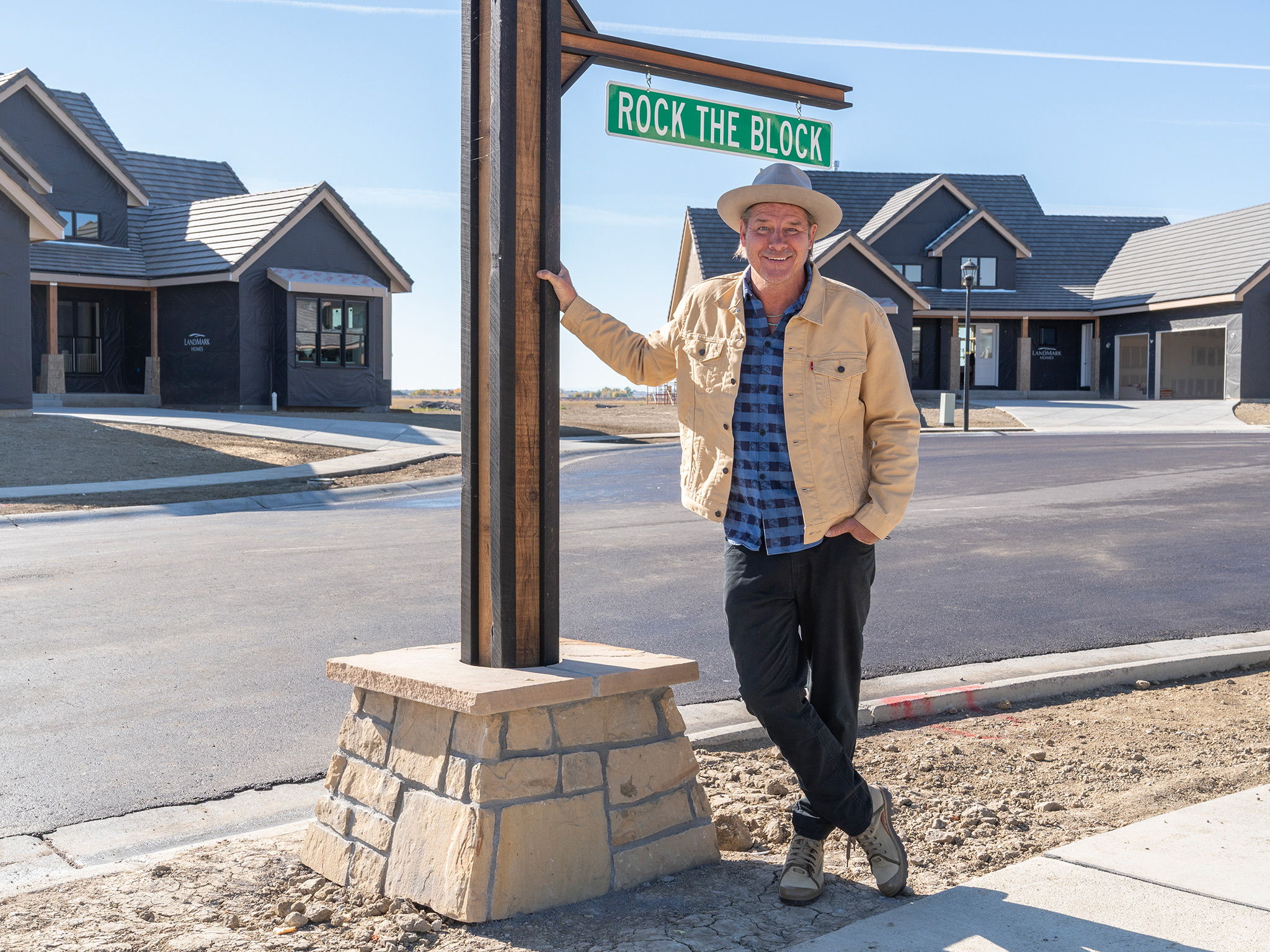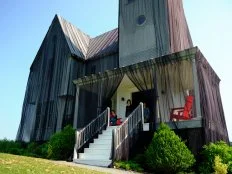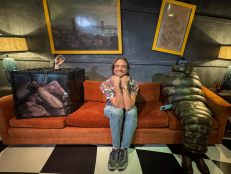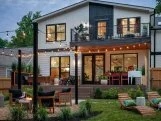Here’s How the ‘Beetlejuice Beetlejuice’ Team Brought Its Iconic World to (After) Life
Production designer Mark Scruton and set decorator David Morison joined forces to research, resurrect and revel in the ‘handmade insanity’ of Tim Burton’s long, long-awaited sequel. Watch our interview and get scary-good shopping inspiration from Beetlejuice Beetlejuice.

© 2023 WBEI
The Deetz house in the fictional town of Winter River was constructed for the 1988 movie, demolished afterward and reconstructed on the same spot for Beetlejuice Beetlejuice.
Moviegoers have been dying to see more of Beetlejuice — both the beloved original film and its delightfully repulsive title character — since spring of 1988, when what we understood of shrimp cocktail’s capabilities changed forever. Director Tim Burton has been just as eager to revisit his horror-comedy classic. “This was his pet project that he’d been gestating [for] 30 years,” explained Mark Scruton, the new movie’s production designer. That project has premiered at last — and Beetlejuice Beetlejuice makes things weird all over again. In partnership with set decorator David Morison, Mark dug into the Ghost With the Most’s old stomping grounds — and created eerily true-to-afterlife new ones.
Developing those wonderfully woozy spaces was quite the undertaking. HGTV’s YouTube series HGTV On Set With joined Mark and David to zoom in on everything from rebuilding the fictional town of Winter River, Connecticut, in attic-miniature form to expanding the phantasmagoria of the afterlife.
Watch HGTV On Set With: Beetlejuice Beetlejuice, then join us here to dwell on its delirious details and get tips on conjuring its wicked magic in your home. (Pro tip: If an uncanny door suddenly materializes in your attic or basement, maybe just paper over it and forget you saw anything.)
Putting Practical Effects First

Parisa Taghizadeh, © 2023 WBEI
The Winter River miniature set was Mark's favorite prop from the new film. "It's just a beautiful thing to look at and study, and I could look at it for hours. And I did look at it for hours, in fact!"
Though digital production techniques are now light-years ahead of where they were when Beetlejuice debuted in 1988, the new film owes much more to old-fashioned elbow grease than it does to CGI. “Working on Beetlejuice Beetlejuice, I think the main thing [was] to make everything look real, to dig into the aesthetic of the first film," Mark said. He and his team wanted the sets to feel "handcrafted, as opposed to digital or superslick." One of his first DIYs? The manual he produced to help him re-create those visual recipes. “I went through and screengrabbed the first film almost frame by frame and built this reference book,” he recalled. A flyer that played a key role in the first movie, for example, informed the look of a similar piece in the sequel; alas, there was no archived PDF or font library for that.
The fantastic Winter-River-in-miniature that Barbara and Adam Maitland [Geena Davis and Alec Baldwin’s characters] created in their attic in Beetlejuice, in turn, came back to life for the new movie via landscape drawing and miniature work. As David recalls, “We employed an art director [who] spent weeks looking at Mark’s book and the [original] film and drew every building, [then] went off with a model-making company that built it.” The resulting models took longer to complete than some of the human-sized sets. Because they would be filmed in extreme close-up, each of their details had to be hand-painted. “It had to feel like the Maitlands had built it, and it was the original model,” Mark said.

Courtesy of Warner Bros. Pictures, © 2023 WBEI
When you need to recreate a labor-of-love miniature town, you commission an honest-to-goodness team of miniature-town-builders, of course. (The town was miniature, mind you. The builders were builder-sized.)
That painstaking work was well worth the effort. "I was on set when Winona Ryder saw the attic set; I think it was the first time she’d seen the model in [30] years, [and] she seemed to be quite emotional about that," David recalled. "As you would be! I was, too!"
Speaking of originals, David and Mark performed some creative landscaping when it came time to zoom in on the model and take a close look at the graveyard lawn from which Michael-Keaton-as-Beetlejuice erupted in the 1988 film. “The grass, you could tell from watching the original film that it was something that [the production team] had sourced,” Mark said. Thirty years later, that spiky foam’s provenance was a mystery. “We couldn’t find anything remotely like it that had that same look, so we had to hand sculpt it and craft it.” The upside of that major project? Once the film had wrapped, that "turf" was a perfect memento for the crew. “I then sliced up and gave people [chunks] as gifts,” Mark recalled, “so everyone had a little piece of Beetlejuice Beetlejuice." “I have one of those on my wall!” David said.

Courtesy of Warner Bros. Pictures, © 2023 WBEI
As in the original film's delirious dinner party, foodstuffs seem to have minds of their own in Beetlejuice Beetlejuice. When this cake comes onscreen, know that it's very much a tangible prop — and that it was proper patisserie the first time it was produced (and became foam in subsequent takes, for reasons we won't reveal here).
Revisiting the Deetz House

Courtesy of Warner Bros. Pictures, © 2023 WBEI
The iconic house on the hill was constructed (and reconstructed) in East Corinth, Vermont.
Returning to the avant-garde Deetz house in the 21st century was also quite the feat. The exterior that Beetlejuice production designer, Bo Welch, created on location in East Corinth, Vermont, was demolished after the first film wrapped. (Fun fact: The house’s fictional and actual creators are a real-life couple, thanks to the film. As Catherine O’Hara [Delia Deetz, who gave the Maitlands' traditional home its singular makeover] told InStyle: “I was grouching to Tim Burton about how this guy was talking to me all the time and never asking me out. We had a break between filming in Los Angeles and on location, and in that time, Tim told Bo that he should ask me out. Our first day of shooting at the house was the day that Bo finally asked me out. So that’s what I see when I look at the scenes we shot there. Matchmaking Tim Burton!”)
Building the Deetz residence (again) was a make-or-break project for Beetlejuice Beetlejuice. As Mark explained, “in the first film the Deetz house is so ingrained into the psyche of the [film’s] world. Tim and I had a conversation about it, and he was like, ‘We need to go back, we can’t do this film if we don’t go back to the original place!’ We built the whole house again exactly as it had been before in exactly the same spot. You could still see a little bit of depression in the ground where the original one had been built.”
The magic of that instantly recognizable building seeped into the team all over again. “When I first drove back there [to East Corinth] and I drove over the hill and the house was on top of the hill, it was like all the hair stood up on the back of my arms,” Mark recalled. “It was like, ‘Oh my god, this is what the film is all about.’”
Discover the Best Small Towns to Celebrate Halloween 20 Photos
Get into the spirit with the best Halloween celebrations in small towns across the country — or let the spirits get into you.
Imagining the Afterlife

Courtesy of Warner Bros. Pictures, © 2023 WBEI
David and Mark's team used tinting to differentiate between environments and realms; each interior space had a chromatic cast of its own.
The human-sized sets — particularly the ones with populations lacking pulses — were a crash course in geometry, emphasis on crash. “The key thing to the afterlife compared to the real-world environments was that everything was distorted and warped,” Mark explained. “Whether that was the furniture, whether that was the walls, it had to discombobulate you in that environment.” Misperception was key to that topsy-turvy atmosphere: “We wanted it to be like you’ve been at a party and you’ve had a bit too much to drink,” David added. “One thing we did with the floors, all the checkerboard floors are distorted and deliberately designed to go against the perspective of the sets,” Mark said. “So even if the floor wasn’t raked or angled or anything else, you’d feel like they are. Regular people would walk on the set and lose their footing because their eyes couldn’t figure out what they were looking at!”

Parisa Taghizadeh, © 2023 WBEI
German Expressionism influenced the off-kilter angles Tim Burton favored as he envisioned the original look of the afterlife.
Lighting and finishes were also central to the afterlife’s otherworldly look. “With the afterlife it was all about metallics,” Mark said. “All the walls were painted initially in chrome-y silver color and then each one was tinted into a different, slightly warmer tone or a slightly cooler tone, depending on the world we were doing.”
Bring the Off-Kilter Look Home
Make a Seat

Courtesy of Warner Bros. Pictures, © 2023 WBEI
"I find the furniture, I get the flooring, everything that is not structural," David explained.
Like the attic miniatures and the Deetz house, the afterlife’s waiting room needed to return to the screen just as it looked three decades ago — and like those elements of the original film, it demanded decidedly creative (re)fabrication. As luck would have it, “some of the drawings did exist in the Warner Brothers archive,” Mark said. Of course, they were incredibly fragile and couldn’t leave the room — so Mark and David had them photographed.
Then, “we were literally looking at stills from the film of people sitting on sofas and measuring their size and measuring the size of the lamps next to them by the actors’ human proportions. It’s the only way that we could get a scale,” David explained. The dimensions that emerged seemed wild — were those table lamps really that huge? — “but they are!” he said.
Happily, there were fortuitous finds to balance out the number-crunching. David stumbled upon a chair with the same profile as a key piece from the waiting room and bought it for £10 (about $13). He then recovered it in leather to mimic the original seat, removed a soft cushion, and voilà. “When [Tim Burton] announced the launch of the film [he shared] a picture of him sitting on it,” he said.
At the Office With Beetlejuice
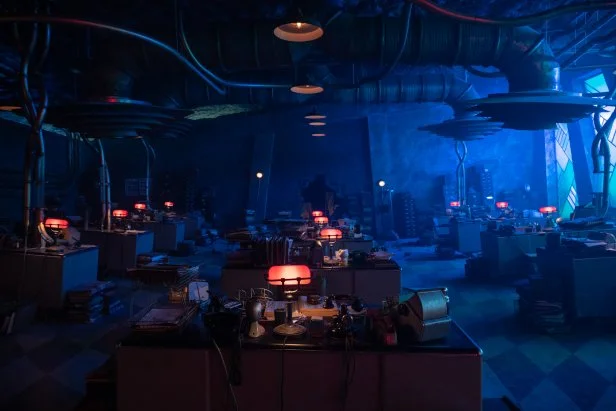
Parisa Taghizadeh, © 2023 WBEI
David’s team built 16 matching, slightly-oversized desks for the boiler room set.
Michael Keaton clocked back in as Beetlejuice on the boiler room set, a cavernous portion of the afterlife where his character is now a bored businessghoul. Keaton, by contrast, was a distinctly delighted actor: “The fun that everyone was having, I haven’t seen that on a set in a long time,” he said. “Everyone who had worked on [the movie] you could tell really enjoyed showing up for work.”
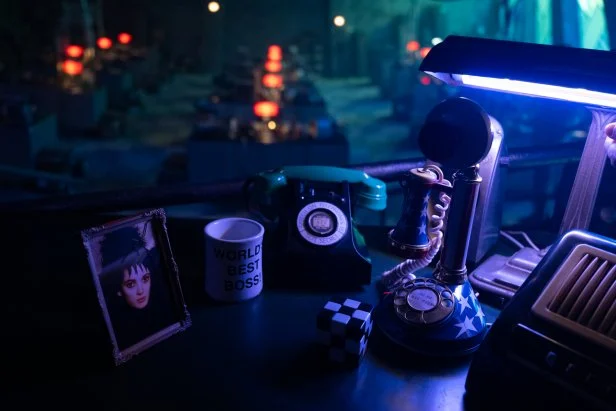
Parisa Taghizadeh, © 2023 WBEI
In Beetlejuice Beetlejuice, the Ghost with the Most leads a sales team of explorers with shrunken heads like the one he encountered at the end of the first film.
Mark and David settled into the afterlife’s vibe so successfully that they surprised themselves. When David dressed Beetlejuice’s desk with everything from two vintage phones and a black-and-white puzzle to a framed photo of Delia Deetz, he expected that Tim Burton and his assistants would see the assortment, leave a few favorite items in place, and remove a few others. Not so: “They walked in and said, ‘This is great!’ and just started shooting with all the stuff and the World’s Best Boss mug,” Mark recalled.
Shop This Look
Wrangling the rest of the boiler room set — and ever-so-slightly-oversized furnishings throughout the afterlife — was significantly more difficult. "Mark decided to make sloping floors," David recalled, "so to try to make all of that secure and work was a challenge. It was fun, but it was a challenge! We had some very large heavy metal filing cabinets [and] we had to tie all of those off to the back wall. I bought some plant pot stands and wedged them under the filing cabinet edges and under chair legs to make everything wonky."
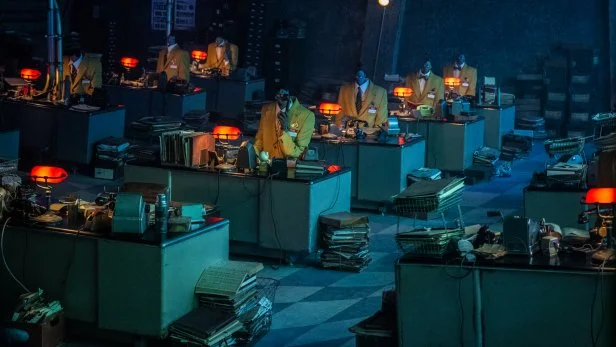
Parisa Taghizadeh, © 2023 WBEI
Traditional bankers' lamps have red shades in the boiler room, a pop of color that recurs throughout the film and Tim Burton's work.
Mass Transit’s Dark Side

Courtesy of Warner Bros. Pictures, © 2023 WBEI
To create the afterlife's own rail car, "[Mark] was able to get hold of a New York subway carriage," David recalled. Keep your eyes peeled in its interior scenes: "The graphics team put some fantastically witty posters on the inside of [it]."
Mark also found himself tackling the singular task of staging a subway car for a spectacular underground-in-the-underworld set piece. “What,” as he recalled asking himself, “would a tube station look like in the afterlife?” Beginning with a single rented piece, he and his team resculpted the front of the train in the shape of a skull, of course.

Courtesy of Warner Bros. Pictures, Courtesy of Warner Bros. Pictures, © 2023 WBEI
"Apart from the clock and some light fittings, there wasn’t a great deal for set [decoration in the train station]," David recalled. "[That] set was not particularly difficult for us." "It was for me!" Mark replied.
Once fabricated, the train had to feel like it was pulling in from a vast tunnel — though the station set was only long enough to shoot 20 or 30 feet. Time for more practical-effects wizardry: “We literally put a big film lamp on a tube and pushed it down the [tunnel] with an iris on it,” Mark explained. The iris opened up as the train got closer, so you got this huge bright light coming down this forced-perspective tunnel.” Burton also wanted a run of lights on the wall opposite the platform, so Mark fabricated beacons that began at "actual" size and appeared to recede down the tunnel by decreasing in size; the smallest light of all was just an inch high. How’s that for movie magic?

Courtesy of Warner Bros. Pictures, © 2023 WBEI
Fair warning: The tune that accompanies the station scene is the one you'll be humming when you leave the theater.
So the station in the afterlife features a skull train, a seemingly endless passage and, of course, more of the film’s woozy geometry. “We made the station a sort of irregular shape [with] the big staircase going up and none of [the steps] are the same height, none of them are the same depth, they’re all at different angles, there’s not one straight angle in the entire set,” Mark said. Naturally, that contorted space frames a musical number. “And [the dancers were all] wearing great big platform shoes!” David recalled. “Huge platform shoes, yeah, so generally I wasn’t popular at all on that set. From anybody at all,” Mark said. “That’s quite correct, yes,” David confirmed.
Channeling Beetlejuice Beetlejuice at Home
With instantly iconic looks, lines and even line dances, it’s no surprise that Beetlejuice has haunted pop culture for 36 years and counting. The film's dark delights have become Tim Burton's signature, and it announced an aesthetic that’s influenced everything from film to furnishings and fashion. Consider that The World of Tim Burton, a traveling exhibition of his work, has been engrossing museumgoers around the world for more than a decade. (Also consider that last summer’s fixation on all things Barbie pink has given way to 2024’s acid green; Beetlejuice is brat.) Trend analysts have dubbed it whimsigoth, and it pops up in the darndest places.
Offbeat, Opulent Whimsigoth Decor Is the Softer Side of Scary 28 Photos
With acrobatic shapes and patterns, fanciful flora and fauna and creative inspiration from Tim Burton, this interior-design aesthetic is ghoulish and goofy in equal measure.
Collaborations celebrating the new film are as thick on the ground as that scaled-up grass Mark and David fabricated for the graveyard; our favorites are the ones that imply a bit of its worlds have oozed into our own. David confessed that the set piece he’d most like to have kept is that old chair from the afterlife waiting room — “but my wife wouldn’t let me,” he said. The things we do for love!







